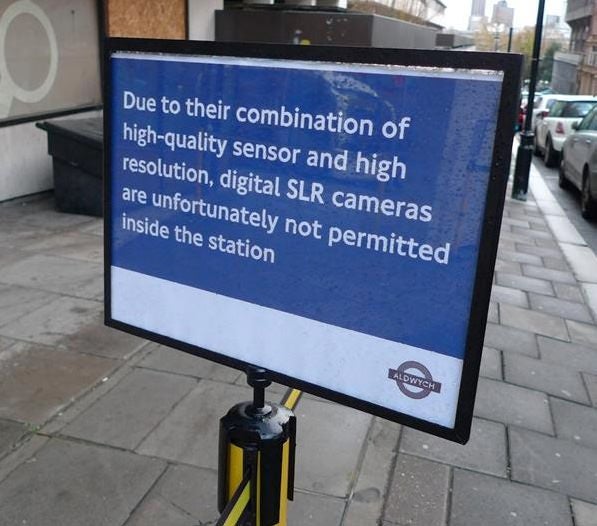DSLRs banned in London Tube Station
Confusing rules on what type of cameras can be used inside an abandoned underground station.


London sign
Any photographer who has visited a major city with their camera knows that the rules governing photography can be tricky. Tripods, flash and other external equipment are often off limits on city streets and transit systems. Many cities also have restrictions commercial vs. personal photography, which can be hard to enforce. And it’s a given that you’ll need a permit if you plan to set up camp at a location for more than 10-15 minutes at most places. (click here for a listing of the official photography rules in many transit systems)
We’ve heard countless bans on photography, including photographers being hassled for taking photos of buildings, bridges, and monuments for fear of terrorism. But the sign outside of London’s Aldwych Underground station banning the use of DSLRs in the abandoned station, is new. The sign reads: “Due to their combination of high-quality sensor and high resolution, digital SLR cameras are unfortunately not permitted inside the station.”
Of course as photographers we know this is a vague categorization that excludes many “high-quality sensor/high resolution” cameras. The abandoned station is open for public tours by the London Transport Museum, and spokesperson Wendy Neville, explained the ban by saying:
“There were restrictions on professional cameras and tripods because we were concerned that people using them could delay the tours for others, as it was a very tight schedule with more than 2500 visitors going up and down a spiral staircase of about 160 steps to get to and from the platforms.”
She further explained that “some DSLRs are big” and posed a safety risk, but made no explanation as to why the sign points to the sensor and resolution quality. The point of the ban is fairly common sense, if you’re on a guided tour in a tight space, it’s pretty obnoxious (and unsafe) to set up your tripod on a narrow staircase for 20 minutes, but banning DSLRs outright (especially when many tourists use a DSLR as their snapshot camera) seems misplaced, especially since it technically leaves even larger medium format cameras in the clear.